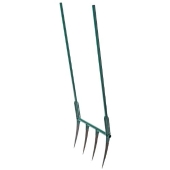First episode posted!
My Journey into Permaculture starts with a kitchen garden, usually put in Zone 0 or Zone 1 in a permaculture design. Most of the episode is about 4x8 foot beds that can be made from materials at a local home improvement store. These beds can be expensive upfront, but if you price out the beds over the years of using the beds, the price is much cheaper. Plus every year you harvest homegrown produce. Raised beds are the easiest way to add depth of organic soil within the first season of growing. Raised beds are best for difficult soils to work with a broad fork such as; rocky soil, compacted hardpan of clay, and contaminated soil. Raised beds can be quick to setup, and can keep animals out easier than a garden row. Fences will need to be kept in mind for larger herbivores and animals, such as deer.
Materials for a 4x8 foot raised bed include: 2x6 boards, hardware cloth or landscape fabric, 4x4 posts or metal plates for bracing the boards, and 3 1/2 inch deck screws. Get a
bed extender for hauling extra long boards.
Alternate raised beds include using a garden barrel design, an up cycling method. Perfect for the urban garden patio, given it can handle the weight. There is a company that makes these in a perfected design called The Garden Project. Their product is more expensive than DIY, however.
A stacked rock garden is great for herb spirals. They are a perfect Zone 0 kitchen herbs garden, mine are pungent smelling, which means deer stay away. A keyhole garden is traditionally made with stacked rock also, and has built in compost section for an extra fertile garden bed.
The
Big-Bag-Bed is a big textile air pot that is great for a first-time raised bed garden that is easily taken with you in a temporary living situation. You can accompany this raised bed with the
Compost Sak, made by the same company. They both need to be in a level ground area, and best not on a deck with neighbors below you. An even better
mobile composter is the Geobin.
Stay in touch and
join our email list. Thanks for tuning into my Journey into Permaculture, see you next time!
#Permaculture #growwithme #sustainability #agriculture #selfsufficiency









